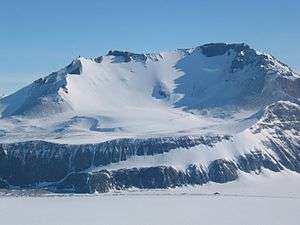Prince Albert Mountains
The Prince Albert Mountains (76°00′S 161°30′E) are a major mountain group in Antarctica over 320 km (200 mi) long. Located in Victoria Land, they run north–south between the Priestley and Ferrar glaicers.[1]
They were named for Prince Albert, the consort of the British Queen Victoria. Although they were discovered by Sir James Clark Ross on February 17, 1841, they were not first explored until the early 1900s, when British cartographers came. They were mapped and surveyed carefully by explorers from the United States and New Zealand in the 1950s and 1960s.[1]
Major peaks

This range include the following mountains:
| Mountain | metres | feet |
|---|---|---|
| Mount Mackintosh | 2,468 | 8,087 |
| Mount Joyce | 1,830 | 6,000 |
| Mount Billing | 1,420 | 4,700 |
| Mount Mallis | 1,360 | 4,462 |
| Mount Priestley | 1,100 | 3,600 |
Other features
Other features or groups of features in the Prince Albert Mountains have been named by various survey groups and expeditions.
Sheppard Rocks (75°37′S 158°38′E) is a group of rocks first mapped by United States Geological Survey (USGS) from surveys and U.S. Navy air photos, 1956–62. Named by Advisory Committee on Antarctic Names (US-ACAN) for Paul D. Sheppard, storekeeper with the South Pole Station winter party in 1966. They lie 4 miles (6 km) northwest of Ricker Hills.[2]
Ricker Hills (75°41′S 159°10′E) is a group of mainly ice-free hills, about 9 nautical miles (17 km) long, lying just west of Hollingsworth Glacier and 4 nautical miles (7 km) north of Bobby Rocks. They were mapped and named by the Southern Party of the New Zealand Geological Survey Antarctic Expedition (NZGSAE), 1962–63, for J.F. Ricker, a geologist with the party.[3]
The Bobby Rocks (75°49′S 159°11′E) are a group of ice-free rocks lying 4 nautical miles (7 km) south of the Ricker Hills. Like the Sheppard Rocks, they were mapped by the USGS from surveys and air photos, 1956–62. They were named by US-ACAN for Bobby J. Davis, a commissaryman with the South Pole Station winter party, 1966.[4]
References
- "Prince Albert Mountains". Geographic Names Information System. United States Geological Survey. Retrieved 2005-03-22.
- "Sheppard Rocks". Geographic Names Information System. United States Geological Survey. Retrieved 2018-08-13.
- "Ricker Hills". Geographic Names Information System. United States Geological Survey. Retrieved 2018-08-13.
- "Bobby Rocks". Geographic Names Information System. United States Geological Survey. Retrieved 2018-08-13.
External links
| Wikimedia Commons has media related to Transantarctic Mountains. |